Decline of Coles’ Sales Growth due to Aldi and Woolworths
VerifiedAdded on 2023/01/23
|8
|1842
|100
AI Summary
This article discusses the decline of Coles’ sales growth due to competition from Aldi and Woolworths in the Australian retail market. It also explores different approaches for sustaining competitive advantages in the market.
Contribute Materials
Your contribution can guide someone’s learning journey. Share your
documents today.
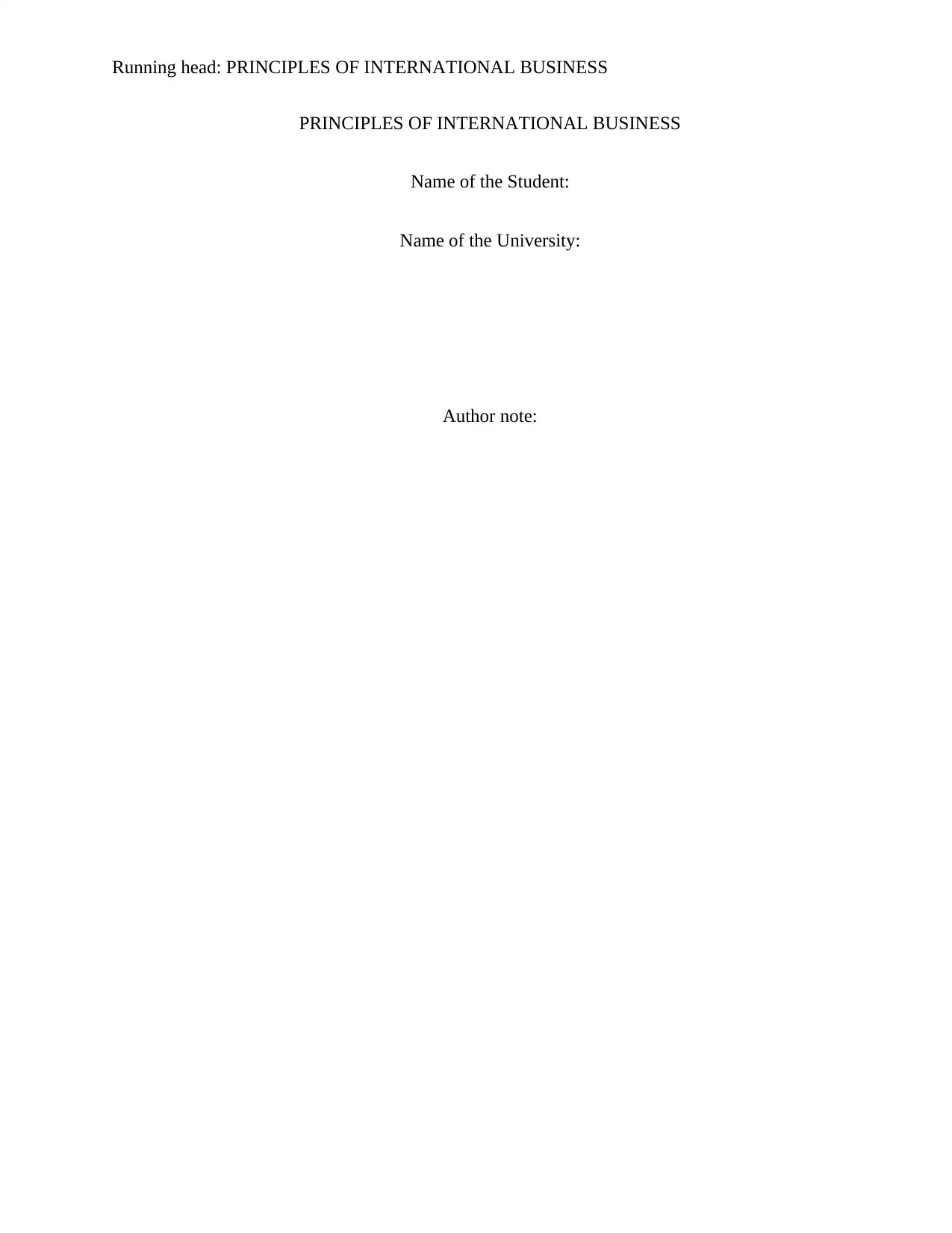
Running head: PRINCIPLES OF INTERNATIONAL BUSINESS
PRINCIPLES OF INTERNATIONAL BUSINESS
Name of the Student:
Name of the University:
Author note:
PRINCIPLES OF INTERNATIONAL BUSINESS
Name of the Student:
Name of the University:
Author note:
Secure Best Marks with AI Grader
Need help grading? Try our AI Grader for instant feedback on your assignments.
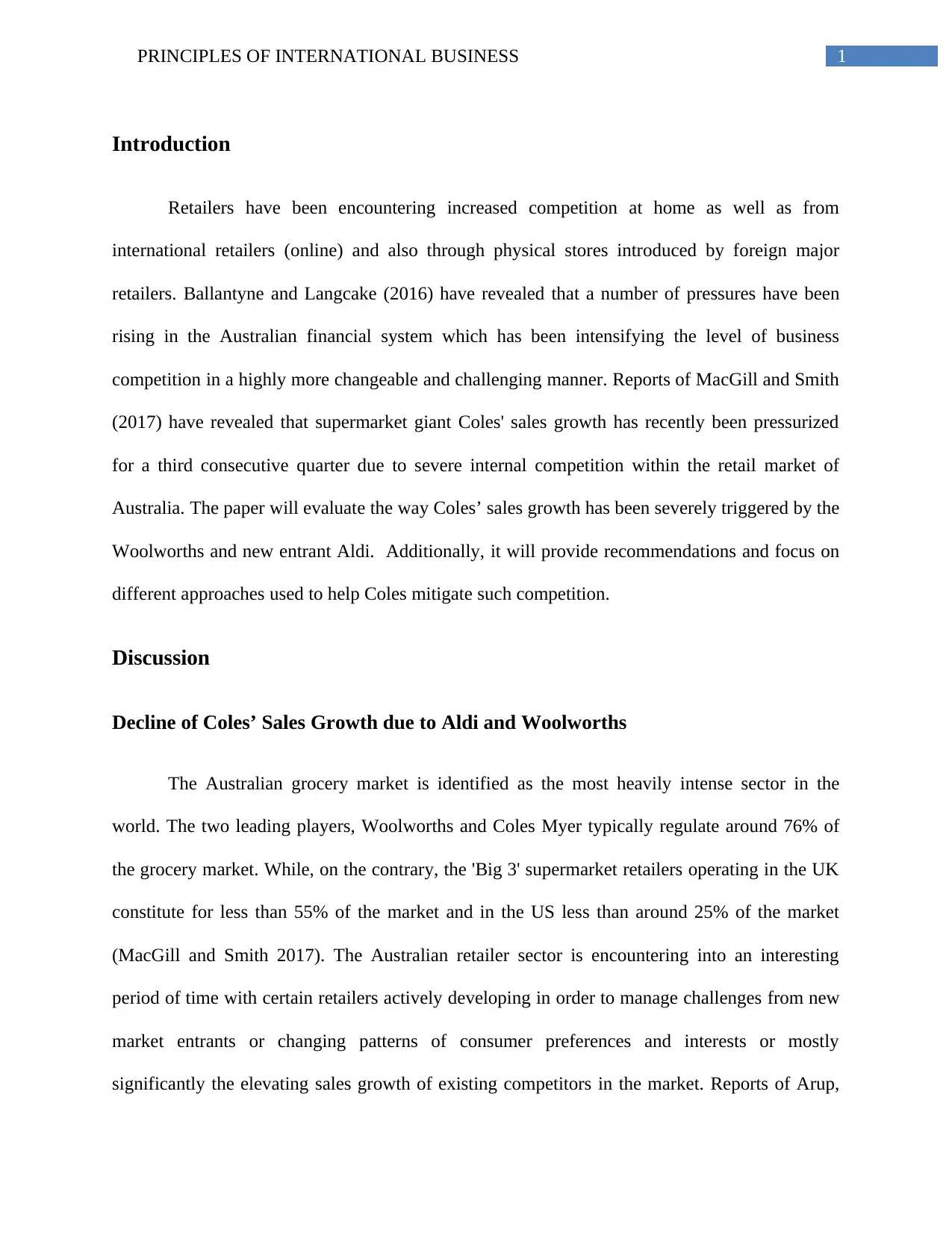
1PRINCIPLES OF INTERNATIONAL BUSINESS
Introduction
Retailers have been encountering increased competition at home as well as from
international retailers (online) and also through physical stores introduced by foreign major
retailers. Ballantyne and Langcake (2016) have revealed that a number of pressures have been
rising in the Australian financial system which has been intensifying the level of business
competition in a highly more changeable and challenging manner. Reports of MacGill and Smith
(2017) have revealed that supermarket giant Coles' sales growth has recently been pressurized
for a third consecutive quarter due to severe internal competition within the retail market of
Australia. The paper will evaluate the way Coles’ sales growth has been severely triggered by the
Woolworths and new entrant Aldi. Additionally, it will provide recommendations and focus on
different approaches used to help Coles mitigate such competition.
Discussion
Decline of Coles’ Sales Growth due to Aldi and Woolworths
The Australian grocery market is identified as the most heavily intense sector in the
world. The two leading players, Woolworths and Coles Myer typically regulate around 76% of
the grocery market. While, on the contrary, the 'Big 3' supermarket retailers operating in the UK
constitute for less than 55% of the market and in the US less than around 25% of the market
(MacGill and Smith 2017). The Australian retailer sector is encountering into an interesting
period of time with certain retailers actively developing in order to manage challenges from new
market entrants or changing patterns of consumer preferences and interests or mostly
significantly the elevating sales growth of existing competitors in the market. Reports of Arup,
Introduction
Retailers have been encountering increased competition at home as well as from
international retailers (online) and also through physical stores introduced by foreign major
retailers. Ballantyne and Langcake (2016) have revealed that a number of pressures have been
rising in the Australian financial system which has been intensifying the level of business
competition in a highly more changeable and challenging manner. Reports of MacGill and Smith
(2017) have revealed that supermarket giant Coles' sales growth has recently been pressurized
for a third consecutive quarter due to severe internal competition within the retail market of
Australia. The paper will evaluate the way Coles’ sales growth has been severely triggered by the
Woolworths and new entrant Aldi. Additionally, it will provide recommendations and focus on
different approaches used to help Coles mitigate such competition.
Discussion
Decline of Coles’ Sales Growth due to Aldi and Woolworths
The Australian grocery market is identified as the most heavily intense sector in the
world. The two leading players, Woolworths and Coles Myer typically regulate around 76% of
the grocery market. While, on the contrary, the 'Big 3' supermarket retailers operating in the UK
constitute for less than 55% of the market and in the US less than around 25% of the market
(MacGill and Smith 2017). The Australian retailer sector is encountering into an interesting
period of time with certain retailers actively developing in order to manage challenges from new
market entrants or changing patterns of consumer preferences and interests or mostly
significantly the elevating sales growth of existing competitors in the market. Reports of Arup,

2PRINCIPLES OF INTERNATIONAL BUSINESS
Beaton-Wells and Paul-Taylor (2017) have revealed that supermarket sector's growth has slowed
as individuals tend to spend less and competition intensifies. Furthermore, authors have
mentioned supermarket Coles has been showing significant lag behind its competitive grocery
retailer, Woolworths in the vast majority of key performance metrics. According to Grimmer et
al. (2017), although Woolworths and Coles have attained significant positions across 26 sub-
categories starting from its internal store performance to its organizational culture, Coles has
been facing incompetence in sustaining its position as a leading retailer in any sub-category.
Drawing relevance to these evidences, Ballantyne and Langcake (2016) have noted that
Coles’ managers and leaders have been finding it highly challenging to cope up with internal
competition within the Australian retail sector. Due to the increasing level of rivalry within the
market, the marketing strategy of Coles has become less effective as well as its strategy has
become reactionary with substantial reliance on price-based endorsements and lack of focus on
other value measures such as quality and community services. On the other hand, authors have
noted that new entrant German retailer, Aldi in the Australian retail sector has been upholding its
pressures on Coles through its investment of over $78 million in reducing its grocery price range
and further raising its sales growth. Moreover, Hatch (2017) has claimed that the Aldi through its
innovative marketing strategies will successfully sustain a position of being Australia’s price
leader regardless of the intense competition within the sector. Woolworths has successfully
invested around $1 billion into its price and services in 18 months, while on the other hand,
Coles has strategically invested $50 million into lower prices for groceries in 2018 and has the
propensity to invest equivalent amount in 2019 (MacGill and Smith 2017). Meanwhile, Rice
(2019) has mentioned that into this intensified and competitive environment, the entry of foreign
retailer Aldi has triggered the customary sales growth of once leading supermarket Coles. Such
Beaton-Wells and Paul-Taylor (2017) have revealed that supermarket sector's growth has slowed
as individuals tend to spend less and competition intensifies. Furthermore, authors have
mentioned supermarket Coles has been showing significant lag behind its competitive grocery
retailer, Woolworths in the vast majority of key performance metrics. According to Grimmer et
al. (2017), although Woolworths and Coles have attained significant positions across 26 sub-
categories starting from its internal store performance to its organizational culture, Coles has
been facing incompetence in sustaining its position as a leading retailer in any sub-category.
Drawing relevance to these evidences, Ballantyne and Langcake (2016) have noted that
Coles’ managers and leaders have been finding it highly challenging to cope up with internal
competition within the Australian retail sector. Due to the increasing level of rivalry within the
market, the marketing strategy of Coles has become less effective as well as its strategy has
become reactionary with substantial reliance on price-based endorsements and lack of focus on
other value measures such as quality and community services. On the other hand, authors have
noted that new entrant German retailer, Aldi in the Australian retail sector has been upholding its
pressures on Coles through its investment of over $78 million in reducing its grocery price range
and further raising its sales growth. Moreover, Hatch (2017) has claimed that the Aldi through its
innovative marketing strategies will successfully sustain a position of being Australia’s price
leader regardless of the intense competition within the sector. Woolworths has successfully
invested around $1 billion into its price and services in 18 months, while on the other hand,
Coles has strategically invested $50 million into lower prices for groceries in 2018 and has the
propensity to invest equivalent amount in 2019 (MacGill and Smith 2017). Meanwhile, Rice
(2019) has mentioned that into this intensified and competitive environment, the entry of foreign
retailer Aldi has triggered the customary sales growth of once leading supermarket Coles. Such
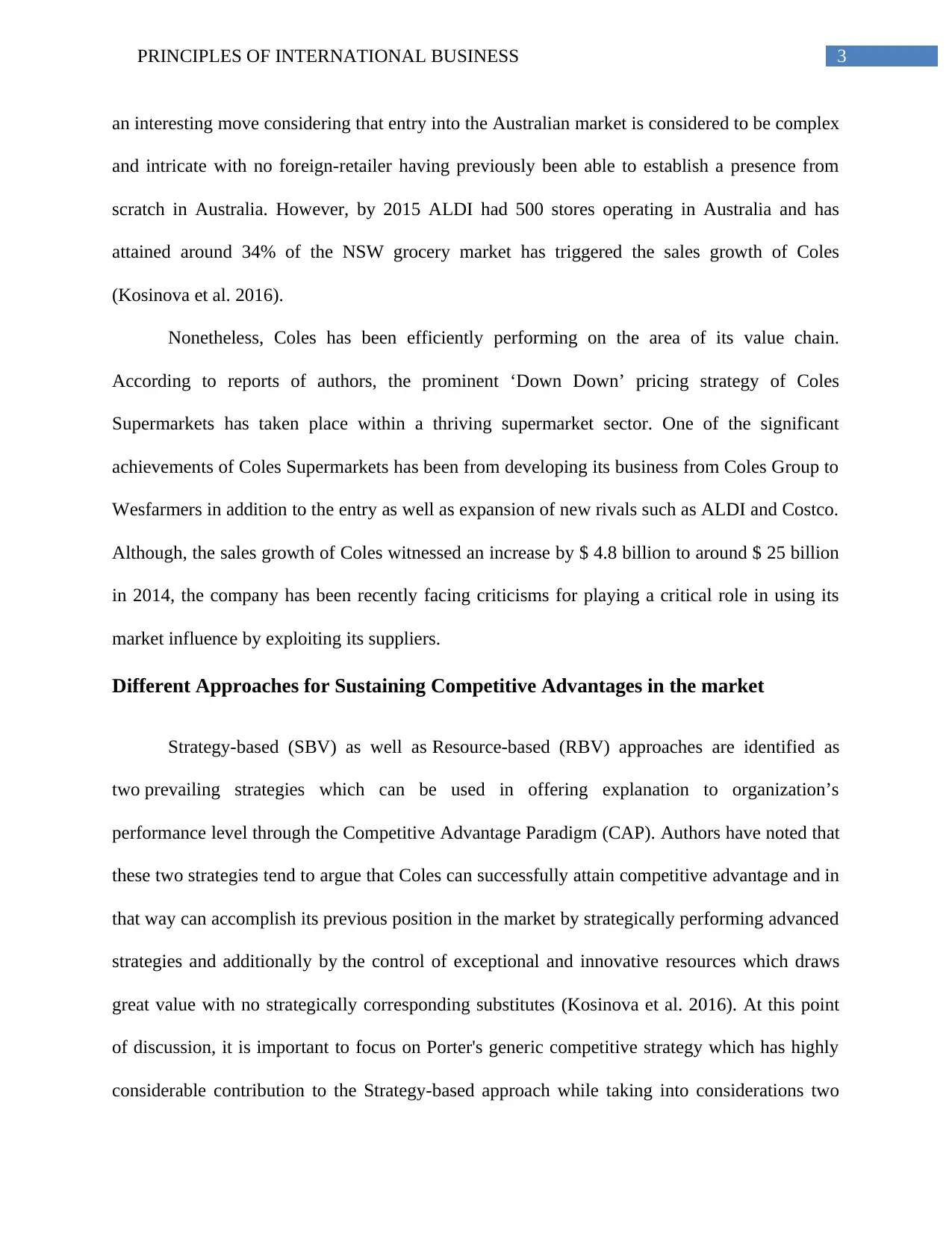
3PRINCIPLES OF INTERNATIONAL BUSINESS
an interesting move considering that entry into the Australian market is considered to be complex
and intricate with no foreign-retailer having previously been able to establish a presence from
scratch in Australia. However, by 2015 ALDI had 500 stores operating in Australia and has
attained around 34% of the NSW grocery market has triggered the sales growth of Coles
(Kosinova et al. 2016).
Nonetheless, Coles has been efficiently performing on the area of its value chain.
According to reports of authors, the prominent ‘Down Down’ pricing strategy of Coles
Supermarkets has taken place within a thriving supermarket sector. One of the significant
achievements of Coles Supermarkets has been from developing its business from Coles Group to
Wesfarmers in addition to the entry as well as expansion of new rivals such as ALDI and Costco.
Although, the sales growth of Coles witnessed an increase by $ 4.8 billion to around $ 25 billion
in 2014, the company has been recently facing criticisms for playing a critical role in using its
market influence by exploiting its suppliers.
Different Approaches for Sustaining Competitive Advantages in the market
Strategy-based (SBV) as well as Resource-based (RBV) approaches are identified as
two prevailing strategies which can be used in offering explanation to organization’s
performance level through the Competitive Advantage Paradigm (CAP). Authors have noted that
these two strategies tend to argue that Coles can successfully attain competitive advantage and in
that way can accomplish its previous position in the market by strategically performing advanced
strategies and additionally by the control of exceptional and innovative resources which draws
great value with no strategically corresponding substitutes (Kosinova et al. 2016). At this point
of discussion, it is important to focus on Porter's generic competitive strategy which has highly
considerable contribution to the Strategy-based approach while taking into considerations two
an interesting move considering that entry into the Australian market is considered to be complex
and intricate with no foreign-retailer having previously been able to establish a presence from
scratch in Australia. However, by 2015 ALDI had 500 stores operating in Australia and has
attained around 34% of the NSW grocery market has triggered the sales growth of Coles
(Kosinova et al. 2016).
Nonetheless, Coles has been efficiently performing on the area of its value chain.
According to reports of authors, the prominent ‘Down Down’ pricing strategy of Coles
Supermarkets has taken place within a thriving supermarket sector. One of the significant
achievements of Coles Supermarkets has been from developing its business from Coles Group to
Wesfarmers in addition to the entry as well as expansion of new rivals such as ALDI and Costco.
Although, the sales growth of Coles witnessed an increase by $ 4.8 billion to around $ 25 billion
in 2014, the company has been recently facing criticisms for playing a critical role in using its
market influence by exploiting its suppliers.
Different Approaches for Sustaining Competitive Advantages in the market
Strategy-based (SBV) as well as Resource-based (RBV) approaches are identified as
two prevailing strategies which can be used in offering explanation to organization’s
performance level through the Competitive Advantage Paradigm (CAP). Authors have noted that
these two strategies tend to argue that Coles can successfully attain competitive advantage and in
that way can accomplish its previous position in the market by strategically performing advanced
strategies and additionally by the control of exceptional and innovative resources which draws
great value with no strategically corresponding substitutes (Kosinova et al. 2016). At this point
of discussion, it is important to focus on Porter's generic competitive strategy which has highly
considerable contribution to the Strategy-based approach while taking into considerations two
Secure Best Marks with AI Grader
Need help grading? Try our AI Grader for instant feedback on your assignments.
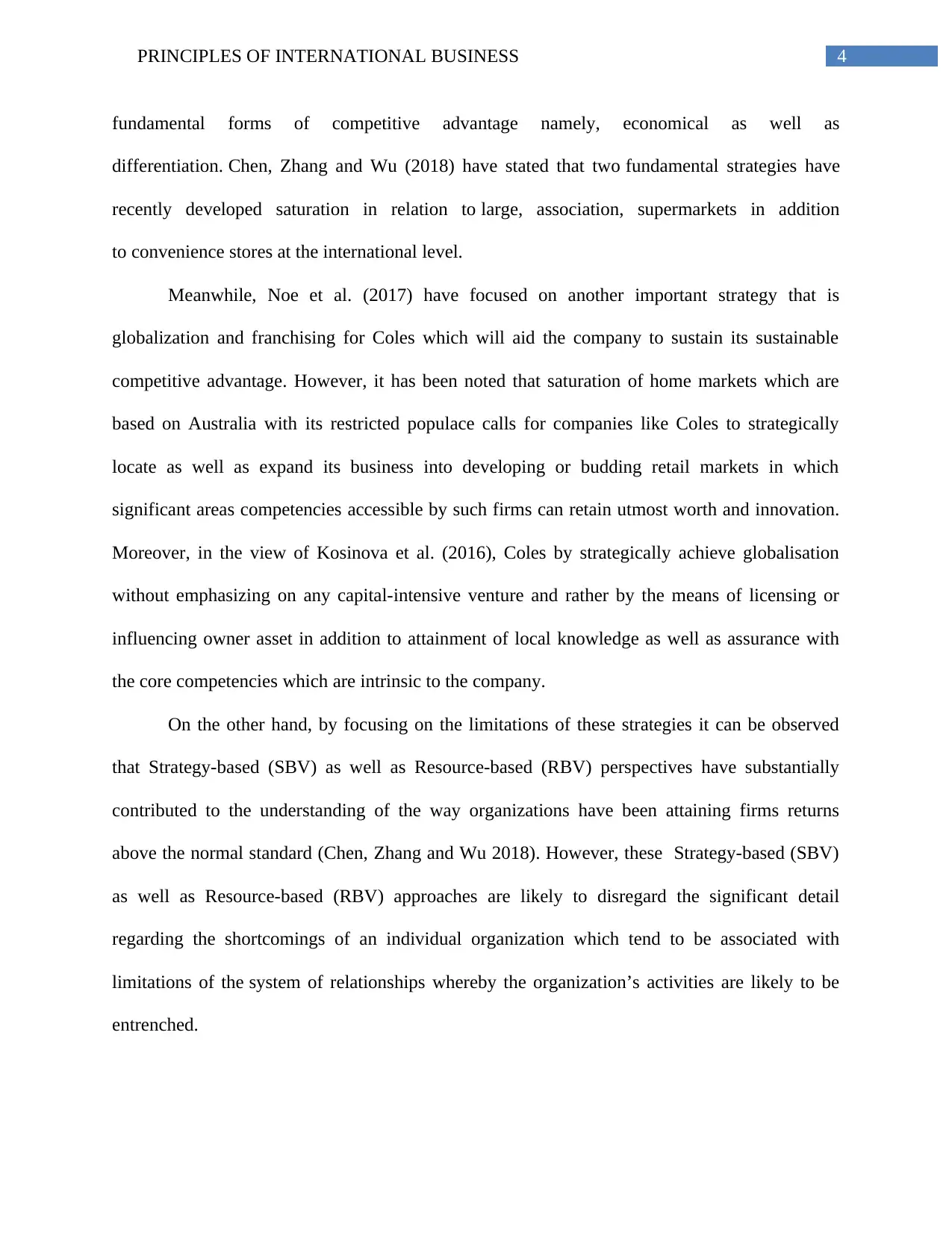
4PRINCIPLES OF INTERNATIONAL BUSINESS
fundamental forms of competitive advantage namely, economical as well as
differentiation. Chen, Zhang and Wu (2018) have stated that two fundamental strategies have
recently developed saturation in relation to large, association, supermarkets in addition
to convenience stores at the international level.
Meanwhile, Noe et al. (2017) have focused on another important strategy that is
globalization and franchising for Coles which will aid the company to sustain its sustainable
competitive advantage. However, it has been noted that saturation of home markets which are
based on Australia with its restricted populace calls for companies like Coles to strategically
locate as well as expand its business into developing or budding retail markets in which
significant areas competencies accessible by such firms can retain utmost worth and innovation.
Moreover, in the view of Kosinova et al. (2016), Coles by strategically achieve globalisation
without emphasizing on any capital-intensive venture and rather by the means of licensing or
influencing owner asset in addition to attainment of local knowledge as well as assurance with
the core competencies which are intrinsic to the company.
On the other hand, by focusing on the limitations of these strategies it can be observed
that Strategy-based (SBV) as well as Resource-based (RBV) perspectives have substantially
contributed to the understanding of the way organizations have been attaining firms returns
above the normal standard (Chen, Zhang and Wu 2018). However, these Strategy-based (SBV)
as well as Resource-based (RBV) approaches are likely to disregard the significant detail
regarding the shortcomings of an individual organization which tend to be associated with
limitations of the system of relationships whereby the organization’s activities are likely to be
entrenched.
fundamental forms of competitive advantage namely, economical as well as
differentiation. Chen, Zhang and Wu (2018) have stated that two fundamental strategies have
recently developed saturation in relation to large, association, supermarkets in addition
to convenience stores at the international level.
Meanwhile, Noe et al. (2017) have focused on another important strategy that is
globalization and franchising for Coles which will aid the company to sustain its sustainable
competitive advantage. However, it has been noted that saturation of home markets which are
based on Australia with its restricted populace calls for companies like Coles to strategically
locate as well as expand its business into developing or budding retail markets in which
significant areas competencies accessible by such firms can retain utmost worth and innovation.
Moreover, in the view of Kosinova et al. (2016), Coles by strategically achieve globalisation
without emphasizing on any capital-intensive venture and rather by the means of licensing or
influencing owner asset in addition to attainment of local knowledge as well as assurance with
the core competencies which are intrinsic to the company.
On the other hand, by focusing on the limitations of these strategies it can be observed
that Strategy-based (SBV) as well as Resource-based (RBV) perspectives have substantially
contributed to the understanding of the way organizations have been attaining firms returns
above the normal standard (Chen, Zhang and Wu 2018). However, these Strategy-based (SBV)
as well as Resource-based (RBV) approaches are likely to disregard the significant detail
regarding the shortcomings of an individual organization which tend to be associated with
limitations of the system of relationships whereby the organization’s activities are likely to be
entrenched.
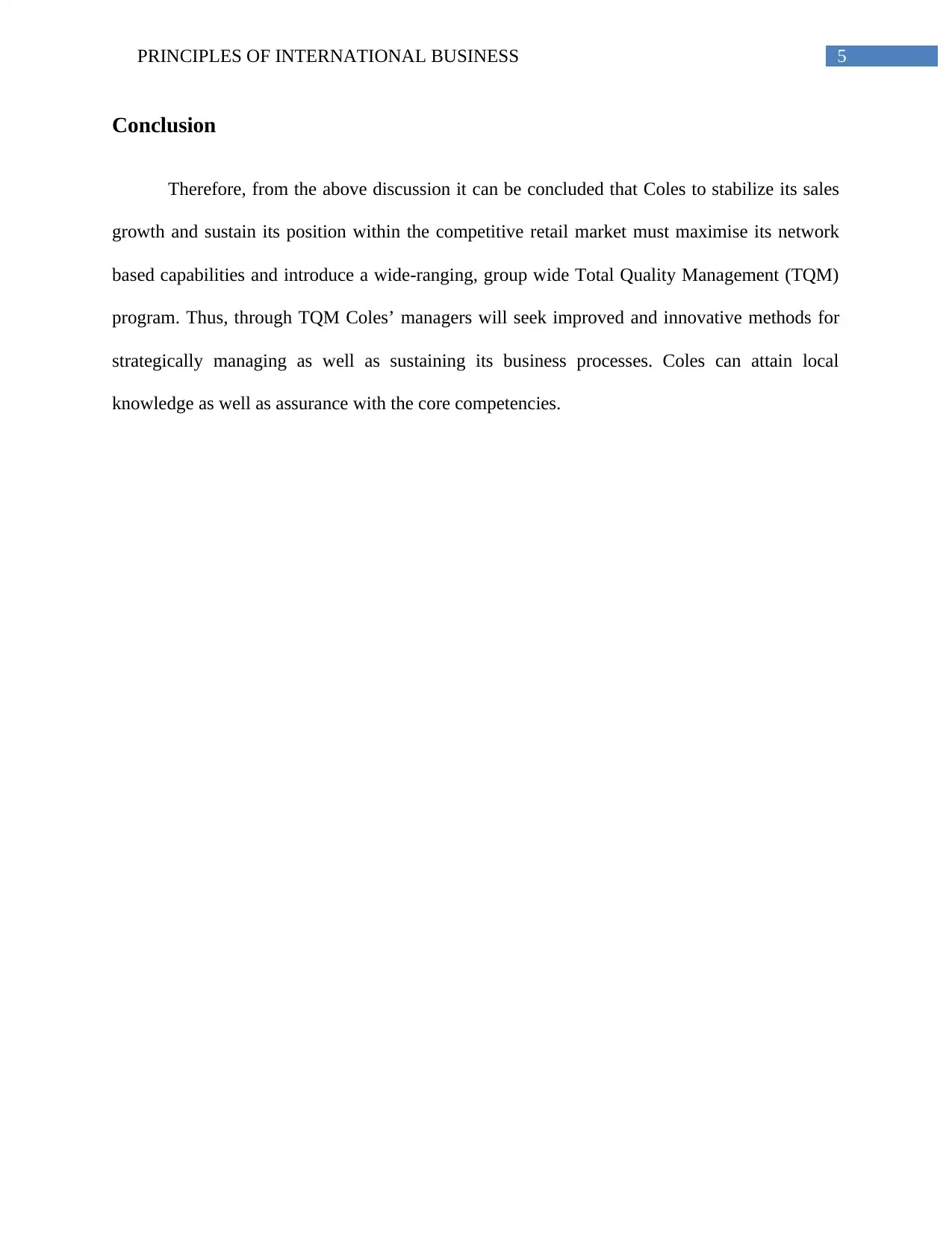
5PRINCIPLES OF INTERNATIONAL BUSINESS
Conclusion
Therefore, from the above discussion it can be concluded that Coles to stabilize its sales
growth and sustain its position within the competitive retail market must maximise its network
based capabilities and introduce a wide-ranging, group wide Total Quality Management (TQM)
program. Thus, through TQM Coles’ managers will seek improved and innovative methods for
strategically managing as well as sustaining its business processes. Coles can attain local
knowledge as well as assurance with the core competencies.
Conclusion
Therefore, from the above discussion it can be concluded that Coles to stabilize its sales
growth and sustain its position within the competitive retail market must maximise its network
based capabilities and introduce a wide-ranging, group wide Total Quality Management (TQM)
program. Thus, through TQM Coles’ managers will seek improved and innovative methods for
strategically managing as well as sustaining its business processes. Coles can attain local
knowledge as well as assurance with the core competencies.
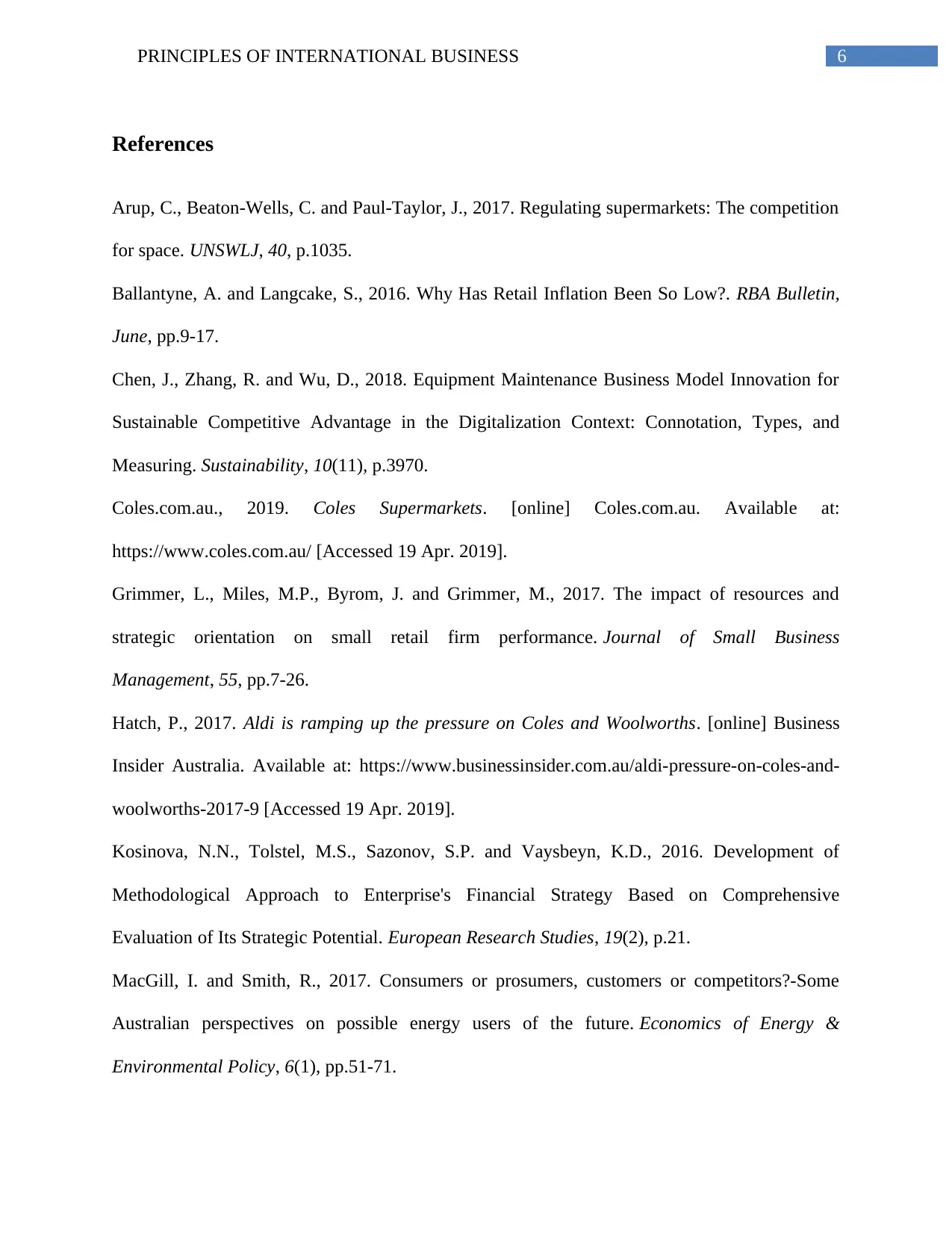
6PRINCIPLES OF INTERNATIONAL BUSINESS
References
Arup, C., Beaton-Wells, C. and Paul-Taylor, J., 2017. Regulating supermarkets: The competition
for space. UNSWLJ, 40, p.1035.
Ballantyne, A. and Langcake, S., 2016. Why Has Retail Inflation Been So Low?. RBA Bulletin,
June, pp.9-17.
Chen, J., Zhang, R. and Wu, D., 2018. Equipment Maintenance Business Model Innovation for
Sustainable Competitive Advantage in the Digitalization Context: Connotation, Types, and
Measuring. Sustainability, 10(11), p.3970.
Coles.com.au., 2019. Coles Supermarkets. [online] Coles.com.au. Available at:
https://www.coles.com.au/ [Accessed 19 Apr. 2019].
Grimmer, L., Miles, M.P., Byrom, J. and Grimmer, M., 2017. The impact of resources and
strategic orientation on small retail firm performance. Journal of Small Business
Management, 55, pp.7-26.
Hatch, P., 2017. Aldi is ramping up the pressure on Coles and Woolworths. [online] Business
Insider Australia. Available at: https://www.businessinsider.com.au/aldi-pressure-on-coles-and-
woolworths-2017-9 [Accessed 19 Apr. 2019].
Kosinova, N.N., Tolstel, M.S., Sazonov, S.P. and Vaysbeyn, K.D., 2016. Development of
Methodological Approach to Enterprise's Financial Strategy Based on Comprehensive
Evaluation of Its Strategic Potential. European Research Studies, 19(2), p.21.
MacGill, I. and Smith, R., 2017. Consumers or prosumers, customers or competitors?-Some
Australian perspectives on possible energy users of the future. Economics of Energy &
Environmental Policy, 6(1), pp.51-71.
References
Arup, C., Beaton-Wells, C. and Paul-Taylor, J., 2017. Regulating supermarkets: The competition
for space. UNSWLJ, 40, p.1035.
Ballantyne, A. and Langcake, S., 2016. Why Has Retail Inflation Been So Low?. RBA Bulletin,
June, pp.9-17.
Chen, J., Zhang, R. and Wu, D., 2018. Equipment Maintenance Business Model Innovation for
Sustainable Competitive Advantage in the Digitalization Context: Connotation, Types, and
Measuring. Sustainability, 10(11), p.3970.
Coles.com.au., 2019. Coles Supermarkets. [online] Coles.com.au. Available at:
https://www.coles.com.au/ [Accessed 19 Apr. 2019].
Grimmer, L., Miles, M.P., Byrom, J. and Grimmer, M., 2017. The impact of resources and
strategic orientation on small retail firm performance. Journal of Small Business
Management, 55, pp.7-26.
Hatch, P., 2017. Aldi is ramping up the pressure on Coles and Woolworths. [online] Business
Insider Australia. Available at: https://www.businessinsider.com.au/aldi-pressure-on-coles-and-
woolworths-2017-9 [Accessed 19 Apr. 2019].
Kosinova, N.N., Tolstel, M.S., Sazonov, S.P. and Vaysbeyn, K.D., 2016. Development of
Methodological Approach to Enterprise's Financial Strategy Based on Comprehensive
Evaluation of Its Strategic Potential. European Research Studies, 19(2), p.21.
MacGill, I. and Smith, R., 2017. Consumers or prosumers, customers or competitors?-Some
Australian perspectives on possible energy users of the future. Economics of Energy &
Environmental Policy, 6(1), pp.51-71.
Paraphrase This Document
Need a fresh take? Get an instant paraphrase of this document with our AI Paraphraser
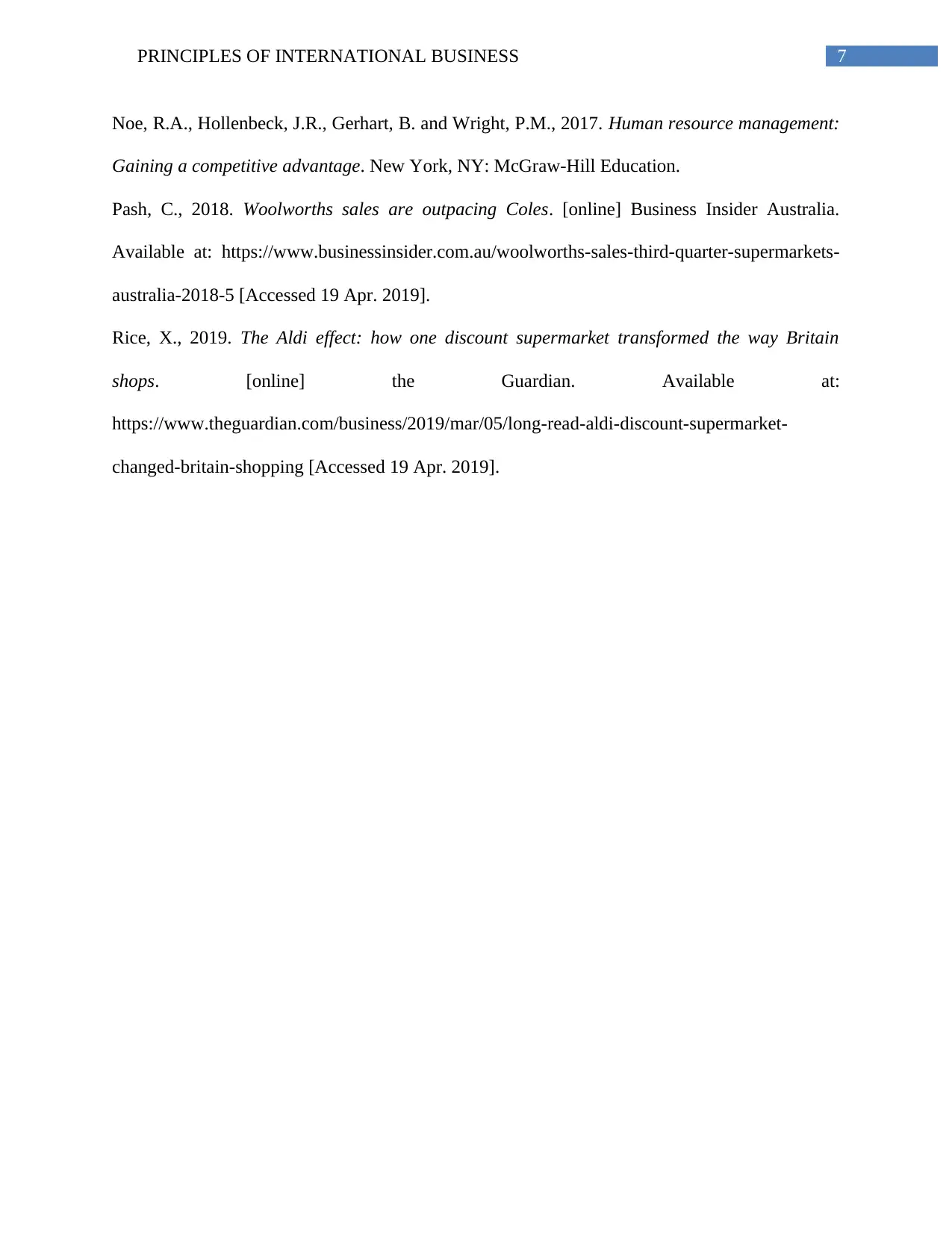
7PRINCIPLES OF INTERNATIONAL BUSINESS
Noe, R.A., Hollenbeck, J.R., Gerhart, B. and Wright, P.M., 2017. Human resource management:
Gaining a competitive advantage. New York, NY: McGraw-Hill Education.
Pash, C., 2018. Woolworths sales are outpacing Coles. [online] Business Insider Australia.
Available at: https://www.businessinsider.com.au/woolworths-sales-third-quarter-supermarkets-
australia-2018-5 [Accessed 19 Apr. 2019].
Rice, X., 2019. The Aldi effect: how one discount supermarket transformed the way Britain
shops. [online] the Guardian. Available at:
https://www.theguardian.com/business/2019/mar/05/long-read-aldi-discount-supermarket-
changed-britain-shopping [Accessed 19 Apr. 2019].
Noe, R.A., Hollenbeck, J.R., Gerhart, B. and Wright, P.M., 2017. Human resource management:
Gaining a competitive advantage. New York, NY: McGraw-Hill Education.
Pash, C., 2018. Woolworths sales are outpacing Coles. [online] Business Insider Australia.
Available at: https://www.businessinsider.com.au/woolworths-sales-third-quarter-supermarkets-
australia-2018-5 [Accessed 19 Apr. 2019].
Rice, X., 2019. The Aldi effect: how one discount supermarket transformed the way Britain
shops. [online] the Guardian. Available at:
https://www.theguardian.com/business/2019/mar/05/long-read-aldi-discount-supermarket-
changed-britain-shopping [Accessed 19 Apr. 2019].
1 out of 8
Related Documents
Your All-in-One AI-Powered Toolkit for Academic Success.
+13062052269
info@desklib.com
Available 24*7 on WhatsApp / Email
![[object Object]](/_next/static/media/star-bottom.7253800d.svg)
Unlock your academic potential
© 2024 | Zucol Services PVT LTD | All rights reserved.




